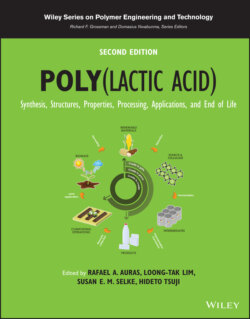Читать книгу Poly(lactic acid) - Группа авторов - Страница 30
1.2.5.1 Purification Methods for Lactic Acid
ОглавлениеCrude lactic acid, which may be upgraded by simple active carbon treatment and/or ion exchange to remove impurities and salts, can be directly used in a large number of food applications. Traditionally, taste, smell, and heat stability for color formation have been used to express lactic acid quality. The presence of acids (e.g., acetic acid and pyruvic acid), alcohols (e.g., methanol and ethanol), and esters can directly influence taste and smell [4]. The presence of residual sugar and nitrogen compounds greatly influences heated color, that is, browning of the liquid upon heating. The formation of color upon heating prohibits the use of crude acid in foods that need to undergo pasteurization/sterilization. Over the decades, the demand for purer lactic acid with improved color stability upon heating has increased, as exemplified by the need for ultrapure lactic acid as a sodium lactate base in pharmaceutical infusion products. At present, a chemical engineer can choose from a number of mature industrial methods to purify lactic acid. Table 1.2 lists their relative advantages and disadvantages.
Choices in an overall process are governed by raw material costs, utility costs, and, last but not least, outlets for by‐products.
The purification methods described above each involve considerable technological know‐how:
Esterification/Saponification. Esterification of lactic acid with methanol/ethanol yields systems with good separation characteristics to separate many impurities with different boiling points [60]. However, the energy demand of a full reaction/distillation route from crude acid to pure acid is high.
Crystallization. Crystallization can yield an excellent lactic acid grade, but the yield is low.
Lactic Acid Distillation. Industrial equipment is available to distill lactic acid at low vacuum. Higher‐molecular‐weight components such as sugar and protein will leave the system as a residue. Heat‐stable lactic acid is obtained as the top product. In the stages of dewatering the crude lactic acid prior to distillation, the formation of oligomers will limit an overall high distillation yield.
Extraction. An extraction/back‐extraction process, for example, with the well‐described tertiary amine systems, is a suitable way to purify lactic acid [61, 62]. The possible combination of extraction with low‐pH fermentation yields an elegant concept to arrive at a gypsum‐free process.
For future large‐scale, low‐cost lactide/PLA production, lactic acid DSP will need to meet new challenges:
Use of Low‐Cost and Nonedible Substrates. Whereas production of lactic acid from sucrose or glucose syrup is well established, crude sources (starches, sugars, or future lignocellulose hydrolysates) will form the next hurdle as they contain much more impurities and possible fermentation inhibitors.
Gypsum‐Free Processing. For large‐scale, sustainable PLA production, a fermentation process that does not coproduce a mineral salt is a must.
